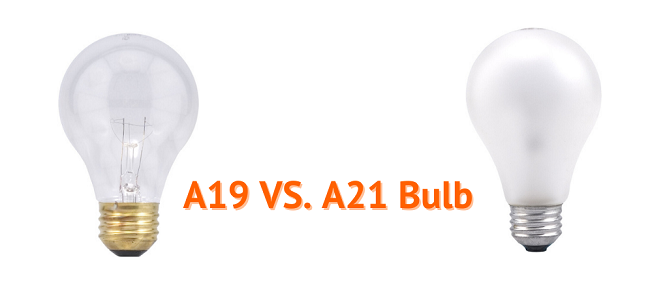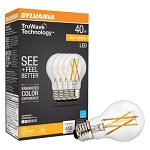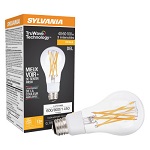If you want to make the right choices for your business or property when selecting A19 and A21 light bulbs, this guide is for you!
The A19 and A21 bulbs have the same shape, and the diameter of the first bulb is 2.375 inches. The larger model is 2.625 inches in diameter. You'll also notice the base height difference in the
A19 vs A21 comparison. The A19 is 4.13 inches tall, while the A21 is closer to 5 inches. You'll get a similar user experience when you buy any bulb with these names, including LED bulbs. For more details, please read on.

The Basic Info for A-type Bulb
The A-type light bulb is the standard, pear-shaped light bulb that comes in various forms including incandescent, CFL, and LED. The most prevalent A-type bulbs are A15, A19, A21, A23, and A25, with A19 and A21 being the most popular due to their optimal blend of brightness and versatility.
The number following the "A" indicates the bulb's diameter in eighths of an inch. For example, the diameter of an A19 bulb is 2.375 inches, while an A21 bulb measures 2.625 inches in diameter.
A19 vs. A21: Which is Better for Your Needs?
As mentioned initially, the primary difference between A19 and A21 light bulbs is their size. Both can fit into a standard E26 socket, making them interchangeable. However, the optimal choice between A19 and A21 depends on their intended application. In this section, we will guide you to choose the ideal light bulb based on its usage.
A19 Bulbs

If you're looking for a versatile bulb that fits well into a wide range of fixtures, the
A19 bulb is an excellent choice. It has been the standard size for over a century, and many light fixture manufacturers design their products to accommodate its dimensions. On the other hand, the A21 bulb may meet installation challenges in smaller fixtures like lampshades, frames, or harps due to its larger size.
A19 has been the standard bulb size for more than 100 years, and most lamp and light fixture manufacturers have designed their products to accommodate the height and width of the A19. If you want to buy a set of light bulbs that fit well in a wide range of fixtures, A19 is a great option. Conversely, if there are some small light fixtures like lampshades, frames, or harps, an A21 light bulb may not be installed since its size is bigger than an A21.
Besides that, the A19 is more economical. Although it may not be as bright as A21, it still produces sufficient illumination, generates less heat, and consumes less electricity. With A19 bulbs, businesses, and individuals can save on energy bills while enjoying well-lit spaces.
A21 Bulbs

When it comes to lighting, size matters. Larger light bulbs, such as the
A21, produce more light than smaller ones like the A19. This is because the more light created the more heat is generated, and larger bulbs can handle higher wattages and dissipate more effectively.
In addition to the brightness and size, it is crucial to consider the layout and dimensions of the space, how the light will be distributed, and the unity budget. For example, offices or workplaces require ample lighting, while living areas benefit from dimmer, warmer lighting.
Except for that, A19 and A21 also differ in their ability to light up space with light. As mentioned above, A21 can light up a stronger and brighter light than A19 bulbs. However, it also means A21 consumes more energy. In this case, if saving energy is your priority, A19 bulbs are the best option. Conversely, if the space needs strong and bright light, A21 bulbs are the superior option.
What Light Bulb Types Are Available in A19 and A21 Bulbs?
When you're ready to upgrade to LED lighting, you'll likely buy bulbs with
A19 or A21 bases. Track and linear or tube lights come with pins or receptacles to use, which means a different base is necessary for those fixtures.
If you're considering the A19 or A21 format only, you'll have the following choices to consider.
|
Light Bulb Type
|
Advantage/Usage
|
|
Standard LED Bulbs
|
The standard LED light bulb disperses light at wide angles throughout a room or outdoor space. It's an ideal choice for hallways, reading lamps, and other common fixtures. You can use them for flush and semi-flush mount fixtures.
|
|
Flood LED Bulbs |
This light bulb is designed to emit a more substantial and broader illumination profile to create light over a wide area. Its primarily used for outdoor needs, but it could serve some warehouses, stadiums, or stages.
|
|
Can LED Bulbs
|
You know this LED light bulb design better as a recessed lighting installation. The product fits into a specific socket, called a “can," that's mounted in the ceiling.
|
|
Candelabra LED Bulbs
|
Chandelier or candle bulbs are designed to look like a flame when installed in a fixture. It's a decorative choice that works well in sconces, accent lighting installations, and decorative fixtures.
|
|
Globe LED Bulbs
|
This choice emits light in all directions. That's why you see them installed in bathrooms or closets. They also serve people well when using them as pendant lights.
|
|
Vintage LED Bulbs
|
These light bulbs are sometimes referred to as “Edisons." Their vintage look is all about the visual aesthetics of the product. Today's designs use long, thin filaments that look like products from the past without compromising the light output levels you receive. They work well in industrial chandeliers or pendant lights.
|
What to Know About Wattage Equivalence
Wattage, or watts, is a measurement of electrical power. When you have one watt, you experience one joule transferred per second. If you're looking at electrical applications and circuits, it's equally easy to translate current to voltage.
If you have a traditional 40W incandescent bulb with an A19 base, it will convert 40 joules of energy into heat and light output each second.
The distinction between heat and light output when comparing incandescent and LED technologies is what generates the energy-saving difference.
If you have a 40W incandescent bulb and a 10W LED bulb that produces equal lumens, you're saving 30 joules per second.
You could purchase a 40W LED bulb, but the power and brightness generated by that technology could light up an entire backyard. That's why wattage is no longer considered an essential measurement of energy. You need to know the lumens rating for a direct product comparison.
With an incandescent bulb, some designs lose up to 90% of the joule expenditures as heat. That means you only get 10% of the energy converted to light with A19 or A21 designs.
LEDs generate the same light with much less wattage because the heat generation process doesn't occur.
In Conclusion
When Comparing A19 vs. A21 light bulbs, the primary difference is the size. You can find higher lumens options with a more extensive base, but the rest of the technology remains the same. The minor differences are not enough to prevent you from using either option in modern fixtures.
Choose the lumens you need, select the LED
color temperature you want, and you'll have a long-term solution for your lighting needs.



